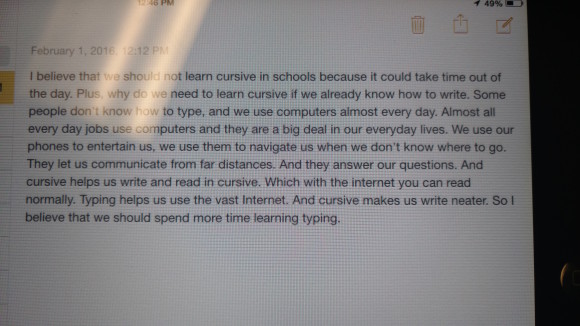
Cursive Mandatory? So 1700s!
A few weeks ago a Bill was introduced here in the State of Washington that would make teaching cursive writing mandatory in elementary schools. Not keyboarding….no in 2016 that should still be optional. But cursive writing…that should be mandatory in 2016. Below is the report from the local news station here in Seattle.
I can’t tell you how frustrated I am we are still having this debate to the point that we’re willing to make it mandatory at the state level! If you want to make something mandatory to learn in 2016, I mean true foundational skills that students need to have in order to be productive citizens, let’s start with:
- Know how to type at 60 words per minute by the end of 8th grade
- Know how to compose an email to a variety of audiences
 Those are two way more important skills that need to be taught in our schools. In my opinion, these are worth taking valuable class time for. I have been talking about this since before 2009. Why are we moving backwards? Why are we talking cursive in a state that is moving towards the state standardized test being only computer based!
Those are two way more important skills that need to be taught in our schools. In my opinion, these are worth taking valuable class time for. I have been talking about this since before 2009. Why are we moving backwards? Why are we talking cursive in a state that is moving towards the state standardized test being only computer based!
To take this a step further, I happened to be subbing in a 5th grade class on Monday (Feb. 1st). I was lucky enough to be in a class where the teacher basically said….they are your’s today..have fun! I love subbing with freedom!
I asked the class this question:
Should you be required to learn how to write in cursive?
We had a discussion about it. Then we watched the above video, did some thinking routines and got to work writing our persuasive pieces on why they thought they should or shouldn’t have to learn cursive writing in school.
The school I was at had iPads that were so locked down that they frustrated all of us (teachers included). There was no writing app on them except the built in Note App, which was buried in a folder called “Not to play with”. Once we all got on the app and starting writing (that took 10 seconds), I couldn’t get them to stop. It’s amazing what happens when you ask kids questions that they feel really matter to them and that they can have a voice in. Of course I ran into an issue when it came time to get their writing off the devices. There was no email connected to the iPads so they couldn’t email me their writing. This also made me have to adjust my original thought which was; we were going to email all of their thoughts to their representatives (seeing in Social Studies they were learning about the revolutionary war and the Sugar and Stamp Acts I thought them having a voice in their learning was a great tie in). Â They couldn’t print it as there was no printer hooked up to them. So this cart of iPads was pretty useless….don’t worry they all had installed and easily accessible on the home page the testing apps the district uses.
Here’s the thing…none of this bothered the kids. They were so happy just to get to use them for something else besides testing that they didn’t care what for. Of course there’s always a way to get your writing off the device. Thanks to this thing called a smartphone that has a camera we solved the issue rather easily.
So instead of me telling the Washington State Congress how crazy of an idea this is…I thought I would let 5th graders make the argument for me.
As you can read not every student thought that they shouldn’t learn cursive. Some thought it was still worth learning. Actually it was 2 out of 20 in the class that believed they should still learn cursive. Oh…that was our math learning for the day. They were learning fractions so we learned that 2/20 or 1/10th of the class believed we should still learn cursive or 1 out of 10 in ratio terms.
So we spent our day learning around one simple, compelling question….and to quote the students “Cursive? So 1700s!”
25 thoughts on “Cursive Mandatory? So 1700s!”
Leave a Reply Cancel reply
This site uses Akismet to reduce spam. Learn how your comment data is processed.
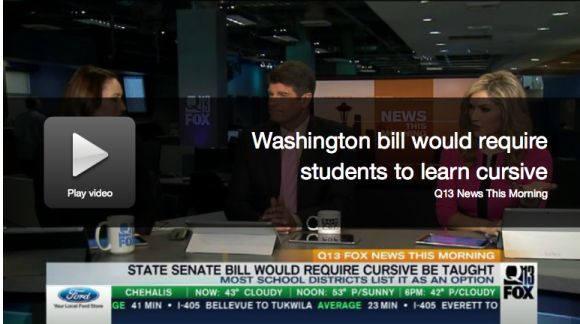
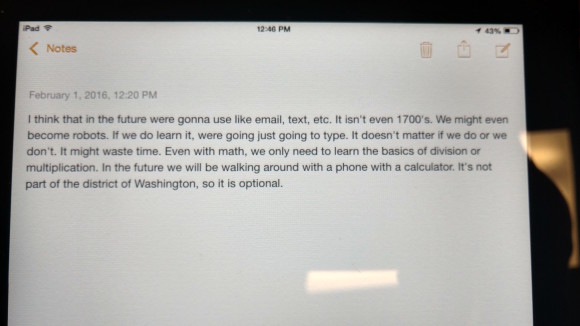
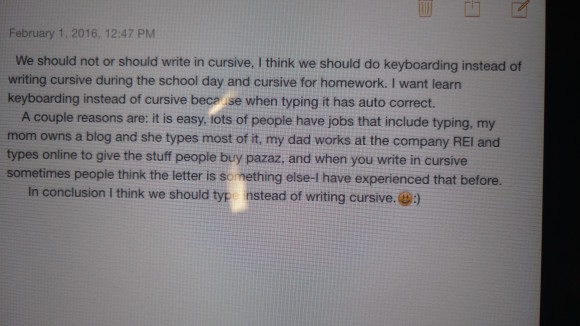
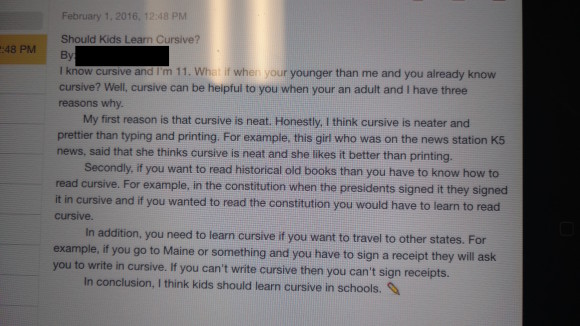
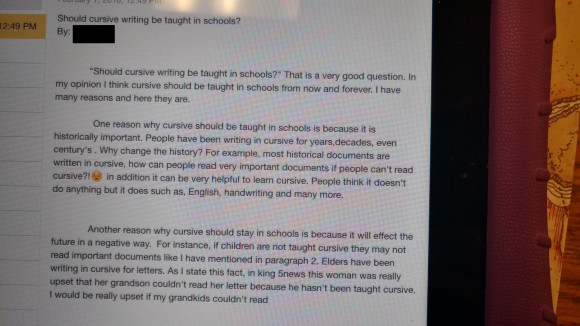







The following will encourage 18 out of those 20 students … and will cause the other 2 to think hard.
—————————————————
The Washington state senator who’s crusading to require cursive (Pam Roach) publicly admits that her own handwriting’s illegible.
She also publicly states that it is not entirely cursive either.
She broadcast this on January 25, on Washington’s KVI radio (second hour of the “Kirby” talk-radio show) 19 minutes, 20-through-45 seconds, into that second hour (in the middle of a segment on her bill).
The segment runs from 13 minutes 49 seconds through 21 minutes 4 seconds of that recorded hour, which you can hear on the Internet: http://kvi.com/podcast/kirbycast-january-25th-hour-2
Why should an illegible writer hold forth on the subject of handwriting instruction — particularly when her aim is to mandate (for millions of her fellow citizens) a way of writing that she does not follow herself?
Still, she has a point. Handwriting matters. Reading cursive matters — but does writing cursive matter? Research shows that legible cursive writing averages no faster than printed handwriting of equal or greater legibility. (Sources for all research are available on request.)
Further research shows that the fastest, clearest handwriters avoid cursive. They join only the most easily joined letter-combinations, leaving others unjoined, using print-like shapes for letters whose printed and cursive shapes disagree. Teaching material for such practical handwriting abounds — especially in the UK and Europe, where this is taught at least as often as the accident-prone cursive that too many North American educators venerate. (Again, sources are available on request.)
Reading cursive — which still matters — is much easier and quicker to master than writing cursive. Reading cursive can be mastered in just 30 to 60 minutes, even by kids who print.
There’s even a free iPad app teaching how: called “Read Cursive.” Given the importance of reading cursive, why not teach it explicitly and quickly, for free, instead of leaving this vital skill to depend upon learning to write in cursive?
Educated adults increasingly quit cursive. In 2012, handwriting teachers were surveyed at a conference hosted by cursive textbook publisher Zaner-Bloser.. Only 37% wrote in cursive; another 8% printed. Most — 55% — wrote with some elements resembling print-writing, others resembling cursive.
When even most handwriting teachers do not follow cursive, why glorify it?
Cursive’s cheerleaders allege that cursive has benefits justifying absolutely anything said or done to promote it. Cheerleaders for cursive repeatedly allege research support — repeatedly citing studies that were misquoted or otherwise misrepresented by the claimant or by some other, earlier misrepresenter whom the claimant innocently trusts.
What about cursive and signatures? Brace yourself: in state and federal law, cursive signatures have no special legal validity over any other kind. (Hard to believe? Ask any attorney!)
Questioned document examiners (specialists in the identification of signatures, verification of documents, etc.) find that the least forgeable signatures are plainest. Most cursive signatures are loose scrawls: the rest, if following cursive’s rules at all, are fairly complicated: easing forgery.
All handwriting, not just cursive, is individual. That is how any first-grade teacher immediately discerns (from print-writing on unsigned work) which child produced it.
Mandating cursive to save handwriting resembles mandating stovepipe hats and crinolines to save clothing.
Kate Gladstone
DIRECTOR, the World Handwriting Contest
CEO, Handwriting Repair/Handwriting That Works
http://www.HandwritingThatWorks.com
handwritingrepair@gmail.com
Why shouldn’t all three be taught? I use all three skills regularly and wish I was better at both cursive and typing even though I learned both in school.
If you have time to teach both…then teach both. Most teachers today don’t feel like they have time to teach either. If that’s the case then we need to make choices. If we have to make a choice I chose the skill of the future not the skill of the past.
Hope all is well BTW!
Time… If we all had more time… I am required to teach a cursive program to my third graders. Due to time, I teach a mini lesson and then my students do a page during their ELA station rotations. Students do need to know how to write their signatures and read cursive; however, I wish I had more time, “working” technology and “working” typing programming to educate my third grade students on a foundational technology skill that they need for the 21st century. I cringe when I think of how many times I have seen my third graders “peck” an answer on their standardized tests, because now high stake tests are computerized. My students, due to their lack of typing instruction and technology access,while taking these portions of their standardized tests that require a “written” a.k.a typed response get frustrated and fatigued and do not demonstrate their full academic ability.
I chose legible letters and accurate syntax (capitals, lower case, apostrophes etc) not print vs cursive. And I like cursive! I would gladly teach typing skills as long as the computer lab/COWs are working. Many students, especially young boys, struggle with fine motor skills. Typing can be much easier than phsyically writing with a pen/cil. Not to mention students love the opp to use technology:)
Is there a bigger question? Cursive may be as the student in your class put it be so 1700s, but which is better for cognitive function? Do our brains work differently when we use a keyboard than when we use pen and paper? (Cursive or Print)
Should the bigger question be should we be teaching students handwriting and keyboarding? If there is not enough time for teachers to teach what is essential, then what do we need to take out of the curriculum?
If you have enough time to teach both…teach both! However more and more teachers aren’t finding time to teach either or only enough time to teach one. If you have to pick one…which one is best for their future? Handwriting is different than cursive….yes there is research out there that shows that writing stimulates different parts of the brain. Parts that associate with deeper connection and thinking. The same is true for video gaming. So why are we not pushing video games if they stimulate the same deep thinking parts of the brain as handwriting does?
@Jeff
I think that is the core of the problem. Why are we not using the most recent research on the brain to inform our teaching? It seems that we give a lot of lip service in education to being cutting edge and then at the same time are unwilling to change. I don’t believe technology is any of its varied forms is the magic pill to cure all the ails the current education system, but I do believe there is much there that can be incorporated into a brain based research model of education.
Actually, Jeff Utecht, researchers and educators ARE increasingly “pushing video games” as a basis for the research. Here’s a book by an educator/researcher who is doing so: http://www.amazon.com/The-Gamer-Generation-Reaping-Benefits-ebook/dp/B007733O8I
And here is more on the topic:
https://www.bing.com/search?q=video+games+are+good+for+you&FORM=AWRE
As far as I have been able Tina, the research on writing — showing that “writing stimulates different parts of the brain … that [are] associate[d] with deeper connection and thinking” is showing those benefits belong to handwriting in _every_ form, including printing: they aren’t somehow limited to cursive. Therefore, the research isn’t good reason to mandate cursive.
Jeff — some people ARE pushing video games for learning and brainpower:
https://www.bing.com/search?q=book+on+video+games+helping+brain&form=APIPA1
Donna — I suspect that the reason so many people stay away from using research is that the research results hurt their feelings. (For example, a proponent of a cursive mandate bill in another state has told me — and, as I recall, her fellow legislators in that state— that she isn’t upset about the fact that she chooses to misrepresent the research on handwriting when she quotes it in favor of cursive because, she’s noticed, that’s the only way she can make the research support cursive — and her feelings tell her that cursive must be supported by any means possible, so she feels that her behavior is ethical because it’s for a cause that she feels very strongly about,)
If students struggle with fine motor skills lets do something that negates them having to enhance those skills for the sake of convenience?? Really?
And to the teacher who wrote this article, the entire time I was reading this I felt that you had so much disagreement with the thought of having to teach cursive again. This disagreement/anger led to you instructing the children to write a paper after probably seeing the way you felt about it and like most children, they are going to want to write something that makes their teacher happy.
I think it was childish to ask them to do that and attempt to take it to a higher level. If you have a problem with the way things are, use your own voice. Cursive is not a bad thing to have in your tool box. Most kids can’t even sign their own name to documents. Cursive is a beautiful language that allows for more expression when communicating with others. Each persona actually develops their own style when their writing in cursive. It’s a personal stamp saying hey..I’m not just another computer hugging keyboarder with no true name or identification, except for the one the JavaScript variable is holding for me to be placed on the page without me even having to touch a keyboard, making my own name seem odd to even see at times.
-all of this coming from me (a web designer/developer who absolutely loves computer code)
In today’s education world, we do need more typing opportunities. Our digital natives need to have foundational skills for technology in order to meet their educational needs in the 21st century. More and more standardized tests are on the computer and I cringe when I see my third grade students “type” or should I say “peck” responses on their laptops. Unfortunately, due to many school districts lack of technology for younger students, students do not demonstrate their full potential on their standardized tests written responses not due to lack of academic ability but due to their lack of knowledge of how to type. Students get frustrated and fatigued; therefore, they just stop and don’t demonstrate their full potential. I feel cursive instruction does have a place, perhaps at a station/center; however, I would love more technology and time to practice typing skills first.
My fine motor skills have always been lacking and cursive was the bane of my grade school existence. I made up my mind when I started high school that I would use basic printing only and have stuck to that to this day with great success (49 yrs old). My children are still forced to learn it and it is a waste of their time. They will not have an official keyboarding class until high school and that is a shame. I have read other articles about this and see no compelling reason why cursive needs to be taught or used any longer.
I teach in a school in Shanghai which bans computers and mobile phones, no wifi for teachers in the classrooms and the kids are required to use pens and paper to write all their exams and tests (internal and external).
Because Chinese writing does not require characters to be written on lines I find the writing of a large minority of my students is dreadful. It’s not just the roller coaster style of the writing – sometimes above the line, sometimes below, sometimes across the line, but the formation of the letters too.
None of them join letters together and the result is that for many students, they go all over the place. I have spent some time trying to get them to improve the quality of their written work by teaching cursive writing and trying to get them to form their letters correctly.
Cursive writing has benefits for those who need to write for exams. Not only does it help keep the words straight and on the line but with practice it can also help speed up writing – something that’s important in an exam.
Of course keyboard skills are important but in my school there’s no opportunity to teach those.
I think cursive is valuable in regards to history and interpreting documents. In order to properly understand primary source documents from the particular time period students need to be able to decipher the specific letters. Before they can do this, it is essential for them to be able to write on their own in cursive. In addition, cursive allows for a more efficient path to taking notes. It saves time and is also important in being able to sign their name, which is a life skill. However, plain print writing is important because this is the mode of literacy that is used in the interaction of technology. I believe that plain print and cursive should be both taught, however in stages. In elementary school it should be reinforced then in secondary education, plain print should be highlighted.
Hi Christian,
Let’s look at this through a future forward lense for a second.
Except that most…not all but most historical documents are now online. You can get them for free for for a small fee.
So I teach students how to access these primary sources http://news.google.com/newspapers you can go all the way back into the 1800 and see newspapers. In print not cursive. There are very few if any documents I can think of looking at the curriculum that wouldn’t have things in print that students can read.
No…not really. There is no correlation between being able to read cursive and write cursive. If you want students to read cursive then teach them how to read and recognize those letters. You do not need to take class time to teach students how to write cursive if all you want them to do is read cursive.
More efficient than what? I find very few adults today who take cursive notes. Under the age of 30 hardly any. So an 18 year old or a 10 year old today probably won’t need to. If it’s efficience you are after then teach them how to talk to their computer and it takes the notes for them.
Ah…the sign your name argument. I filed my taxes without signing, I just went to the store and purchased things with my phone…no need to sign. In fact America is one of the last western nations that requires you to sign a receipt. It is the most in-secure part of the purchasing process. Looking forward we better be teaching them how to buy things with their phone not with a signature.
Plain print is what the world uses. If we want our students to be global citizens learning to write in plain text is way more important than cursive. The number one english speaking country today is China. They all read plain print we would better serve our students by making sure they could type 60 words a minute in plain text. Where are we spending time on that skill in our schools and classrooms.
I have yet to find a teacher beyond 4th grade that requires students to write in cursive. We in education don’t even require students to practice it after they learn it in 3rd grade.
I’m not against teaching cursive…if a teacher has time to teach cursive then teach it! Just don’t then complain that you don’t have time to teach typing.
Hi Jeff,
I understand the forward thinking through the technology lens and how that makes teaching cursive somewhat obsolete. I find it remarkable the technology that we have at our disposal that eliminates this need for cursive writing. I believe it is also a great opportunity for students to be exposed to new online material that allows the deciphering of primary sources. However, the reality is that students may not always have the access to this type of technology. We have to prepare students for all different scenarios. If we take math for example, should we not teach students math skills because they can be done on a calculator anyway? But you are correct that it should not be taught at the cost of utilizing technology for their benefit.
-Christian
Christian — To apply and extend your calculator analogy: when we don’t have a calculator, doing arithmetic by hand does not mean we’d have to do it in Roman numerals. Likewise, writing by hand does not mean we have to do it in cursive — since other forms of our familiar alphabet exist, and at least one of these forms (italic handwriting) permits documentably greater speed and legibility. To see italic, which you’ve probably seen before now without realizing it has a name: graphics8.nytimes.com/images/2009/09/08/opinion/OPED-WRITING.1.pdf, briem.net, italic-handwriting.org, studioarts.net/calligraphy/italic/hwlesson.html, BFHhandwriting.com, handwritingsuccess.com, Lexercise.com, HandwritingThatWorks.com, freehandwriting.net/educational.html
I’ll add that learning to read cursive — just read it — takes no more than an hour when you know how to read print. There’s even a free iPad app to teach how — called “Read Cursive” — and (to my personal knowledge) the successful users include some four-year-olds (who are now out there fluently reading cursive that they’ve never learned how to write. The time that I told one of these kids that some grownups say you can’t possibly know how to read cursive until you write it too, she just laughed and laughed.)
As a social studies teacher, I completely support the teaching of cursive in elementary schools. I understand your argument Jeff that most primary source documents originally written in cursive are now widely found online but that is only referring to famous or historically significant documents. What happens if I wanted to share my Grandfather’s journal about his adventures in the Merchant Marines following WWII with my class of middle schoolers and they are unable to decipher it? Or if a student wishes to research their own family history but is unable to? The knowledge that learning cursive unlocks is immense and yes while I feel learning to keyboard is highly valuable as well, I do believe this is a skill many students in today’s tech savvy society pick-up on their own and could simply be refined in their secondary studies.
As a social studies teacher I support the teaching cursive in schools. Students will pick keyboarding up naturally by them living in today’s online culture but cursive is a practical skill that can be used to examine documents from the past and to read family members long gone journals and diaries. Keyboarding can easily be refined in secondary schools but cursive should already be a skill being used in secondary classes.
Our district in Washington State, has been using a keyboarding program called QwertyTown as motivation for our students to get through the mandatory handwriting exercises.
The students are constantly asking us why they have to hand write when all the other work they do is on the computer.
We use QwertyTown to show them that both skills are important and that they are both components of literacy.
They should teach cursive writing. I taught cursive all my years of teaching. I would not have it any other way. I start at grade 3.
Time was when a person got hungry, they went home, cooked and ate. Now, they stop at the drive-in window or just go out to eat. People who can barely draft a complete sentence or getting rich writing cookbooks, hosting television shows, editing their own magazines, owning fancy restaurants, and/or owning not fancy at all restaurants. Regardless of what the label, menu or sign says, the fact is that we have no Earthly idea what we are eating out of that window or where ever it came from. Maybe, someday, it will be the same way with people who can read and write cursive. They might be paid to “translate” for those who can’t. Picture it: a job vacancy posting for a cursive translator.